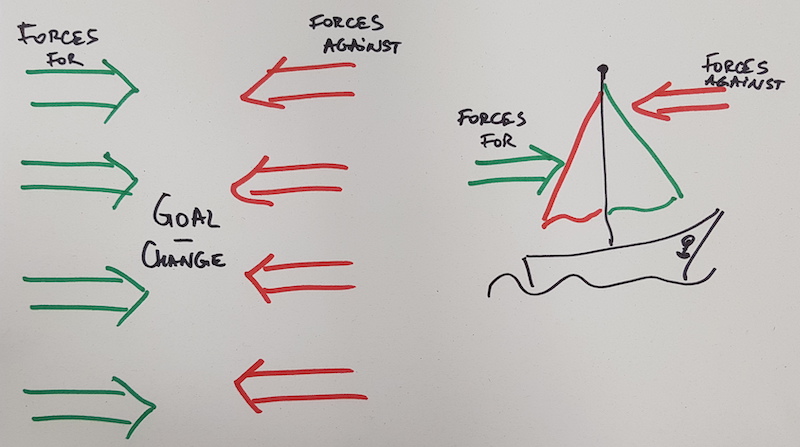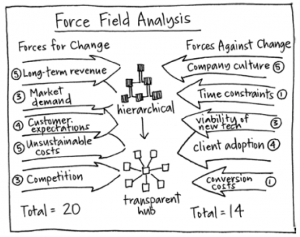Force Field Analysis - Force Field Map
Understanding change/goals
Contributed by
Val Yonchev
Published November 08, 2018
Collection
2
What Is Force Field Analysis - Force Field Map?
This is a simple way for evaluating the forces pro and con that are at play with regards to certain change. Typically, this is a change the organization is interested in or faces.
This is a method coming from the field of Social Science and developed by Kurt Lewin.
Dave Gray has introduced a map (Force Field Map), which provides an excellent canvas for having a conversation with all participants in front of a flipchart or whiteboard.

Why Do Force Field Analysis - Force Field Map?
- Change cannot be managed. It can only be facilitated. To facilitate something one has to build sufficient understanding of it
- Organizational systems are complex systems and require system thinking for their understanding. Force field analysis is a way to open the door to systems thinking in situations where organisations are going through change
- Provides a good understanding of the environment, which in turn could allow for Lean Change Management practices to be used for facilitating the change process
How to do Force Field Analysis - Force Field Map?
- Before the meeting, draw a picture of a potential change in the middle of a large sheet of paper or a whiteboard. You can draw a literal representation (e.g., a manufacturing plant) or a more abstract representation (e.g., a metaphor). Label the picture to ensure that everyone participating will be clear on the topic.
- On the top left of the page, write the phrase “Forces FOR Change”. On the top right, write the phrase “Forces AGAINST Change”.
- Draw arrows on both sides pointing toward the image in the middle. These will be the areas that contain categories generated by the group, so make the arrows large enough to write 1–2-inch letters inside. If you like the “wow” factor of drawing live with the group but you’re not yet comfortable with freehand, sketch the arrows in pencil or yellow marker and trace them during the meeting.
- When the group is gathered, introduce the change topic and explain that the goal of the Force Field Analysis game is to evaluate the feasibility of that change.
- Ask the players to take 5–10 minutes and quietly generate ideas about what elements are driving the change. Tell them to include one idea per sticky note.
- Ask the players to take 5–10 minutes and quietly generate ideas about what elements are restraining the change.
- Draw a simple scale with a range of 1 to 5 on your main flip chart. Indicate that 1 means the force is weak and 5 means the force is strong. Ask them to review each idea FOR change and add a number to that sticky note, weighting that idea. Ask them to review each idea AGAINST change and add a number to that sticky note, weighting that idea.
- Gather all of the sticky notes FOR change and post them to any flat surface viewable by the players.
- With the group’s collaboration, sort the ideas based on their affinity to other ideas. For example, if they produced three sticky notes that say “Can’t continue production at current cost”, “Materials cost too high”, and “Overexpenditure on production”, cluster those ideas together. Create multiple clusters until you have clustered the majority of the sticky notes. Place outliers separate from the clusters but still in playing\nrange.
- After the sorting activity is complete, begin a group conversation to create an overarching category for each cluster. For example, an overarching category for the cluster from step 9 might be “unsustainable costs”.
- As the group makes suggestions and finds agreement on categories, write those categories inside the arrows on the main visual.
- As you categorize each cluster, direct the group’s attention to the numeric scores within that cluster. Get an average for each cluster and write that number next to the related category in the arrow.
- Repeat steps 8–12 using the sticky notes generated AGAINST change.
- Add the quantities for and against change and write the totals at the bottom and on the appropriate side of the sheet.
- Summarize the overall findings with the group, including the numeric totals, and discuss the implications of whether change should occur.
Look at Force Field Analysis - Force Field Map
Links we love
Check out these great links which can help you dive a little deeper into running the Force Field Analysis - Force Field Map practice with your team, customers or stakeholders.

